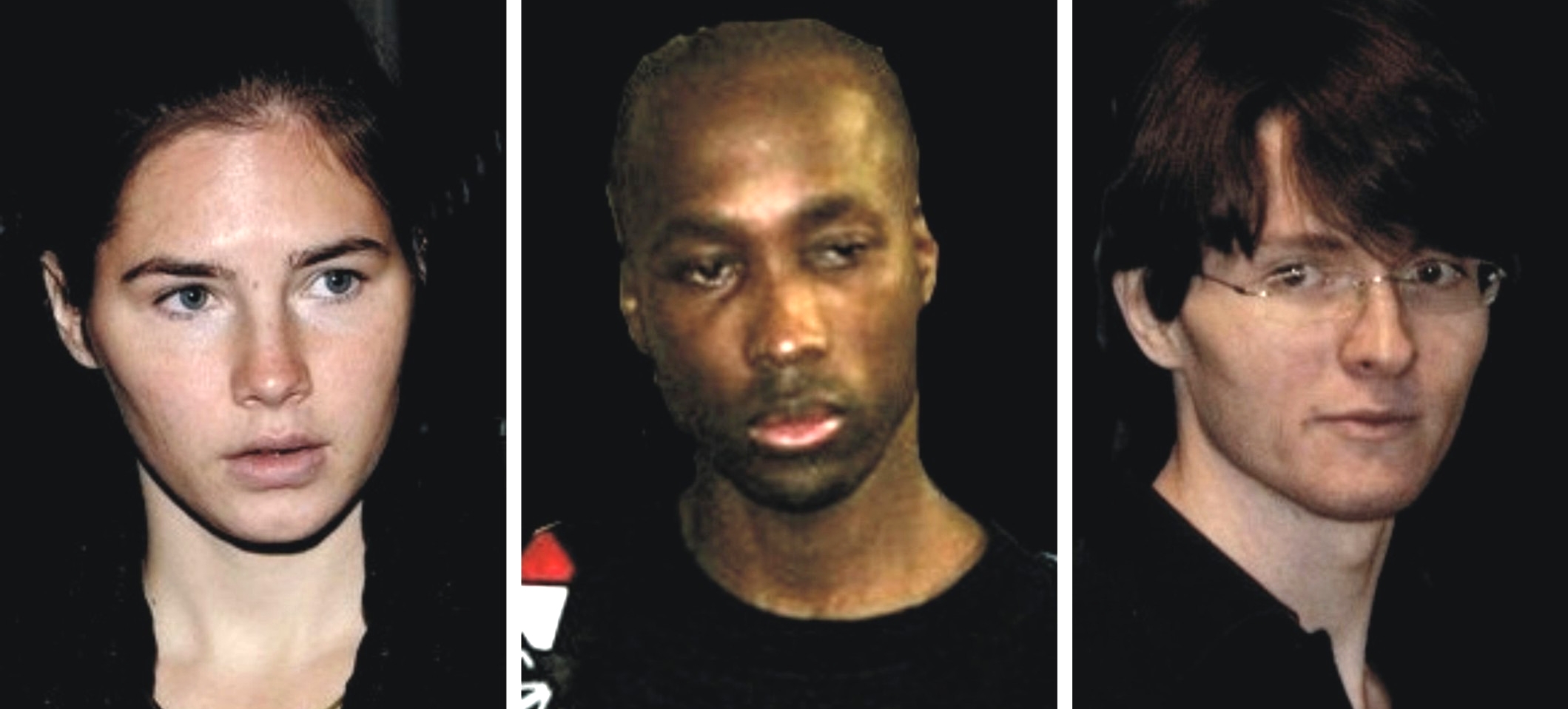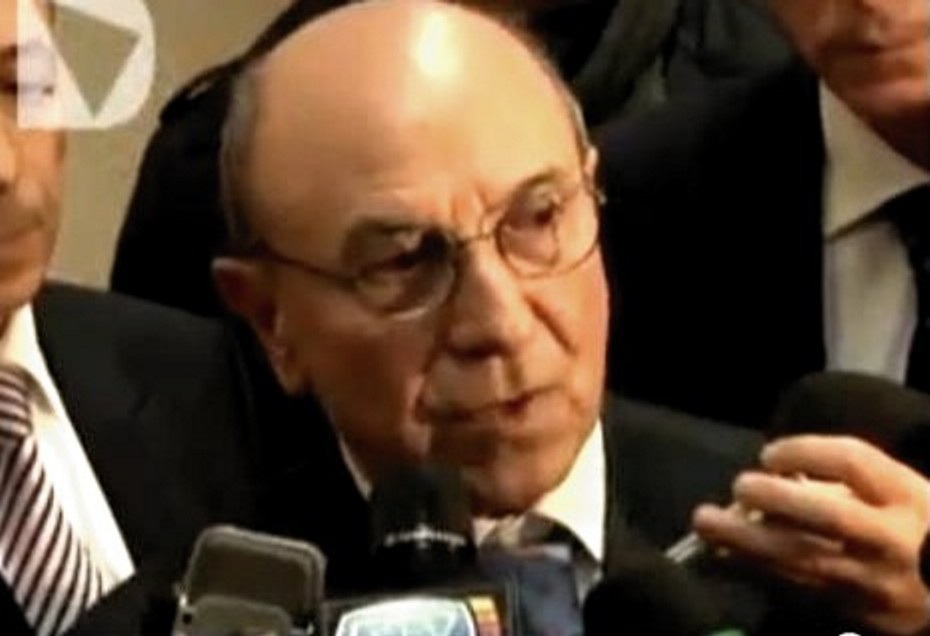
Category: Raff Sollecito #2
Wednesday, May 22, 2013
Seeds Of Betrayal: Sollecito Twice More Implies Evidence Against Knox Much Stronger Than Against Him
Posted by Peter Quennell
Above and below are two videos of TV interviews in the past few days which will give real weapons to the prosecution coming up.
Nobody who is innocent ever needs to lie to contradict a huge amount of evidence to the contrary. At the 2009 trial and the 2011 annulled appeal, Sollecito was kept carefully circumscribed by his own lawyers.
Giulia Bongiorno was often observed firmly making him toe a line. If she liked him, it sure never showed, and she had little response when some fairly disgusting things about him came out.
Sollceito’s spontaneous interventions in court made him look whiny and guilty and never did him any good, and unlike Knox he was never game to be cross-examined by the prosecution on the stand.
But since his release, in his interviews and especially in his self-serving book, he has done his level best to convince the world “I saved Knox!!”.
In both videos, he is repeating the same false claim which has already landed him in such legal trouble in Italy. It is that a desperate Knox needed his support, and he gave it (despite illegal prosecution pleas) without considering the cost to himself.
These questions and these questions and these questions are what competent interviewers could and should have asked. But of course, the silly TV interviewers on NBC Today and KOMO TV in Seattle each nod happily and just wilt.
Here are our takes on the sub-texts of Sollecito’s claim to have selflessly saved Knox.
(1) That the prosecution had a weak case against RS or AK
Those tuning in after 2009 might think so, but in the first half of 2009 the prosecution’s case was smooth, fast and brilliant in the extreme. They figured out a way to get Knox on the stand and to hang herself in her own words.
In contrast, the defense phase late 2009 was halting and uncertain and often with daggers drawn. It never once landed a blow. Defense counsel didnt always turn up, and there were hints that two of them (Bongiorno and Ghirga) might walk.
At the end, of course, the prosecution got a unanimous verdict and all they wanted, less a few years off the sentences for supposed kindness shown to Meredith by the killers. The trial report was praised this past March by the Supreme Court.
The evidence against Sollecito was quite overwhelming (false alibis, computer inactivity, mobile phone inactivity, a credible eye-witness, DNA in Meredith’s room, and of course this on his footprint in Meredith’s blood. Also read this list of lies Sollecito had already told by April 2009.
The prosecution was legally barred from offering any deals, but even in their dreams here, they had zero need.
(2) That Sollecito was loyal to Knox after 6 November 2007
It never happened, as Knox herself knows. Read this astonishing transcript here in which Sollecito’s father is making quite clear what Sollecito must do. Sollecito thereafter separated himself repeatedly from Knox in court and online..
On 6 November 2007 at his witness interview Sollecito cracked fast and turned on Knox, painting her as a liar who had made things up. She then accidentally gave him quite a break, by implicating Patrick instead of him.
Knox has clearly been bothered by this disloyalty ever since. She has tried both to pull him in and to push him away.
In her cell, she pondered whether he was the real killer. She later wrote Sollecito some love letters and once rather desperately asked to meet. And then just the other day she really barked.
When Sollecito’s lawyer Giulia Bongiorno for the first time EVER showed some tolerance for Amanda Knox it was 11 months into the trial and it caused many heads to be scratched.
The code throughout which Sollecito never once broke from was never “honor bound”. It was to throw Knox under the bus. Reporters should confront him hard on this.
Saturday, May 18, 2013
Seeds Of Betrayal: In Interview Knox Reveals To Italy Her Considerable Irritation With Sollecito
Posted by Our Main Posters
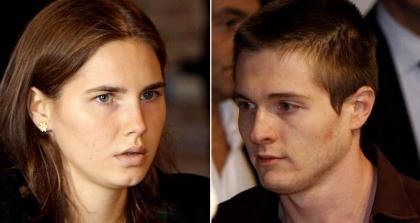
For some odd reason, Amanda Knox has decided she is not loved enough in Italy.
Could it be because she is widely seen to have lied her way through trial, came across as loud, self-absorbed and callous in her 2009 testimony and court interventions, served three years for framing her her kindly employer, was reported as being just as grubby and tin-eared and sharp-elbowed as ever in prison, slimed Italy though her cohorts in much of the English-language media after her 2011 release, and has now written an illegal blood-money book which once again slams a benign Italy?
In particular it slams the justice system, one of the most popular and trusted institutions in Italy, and its officers of the court, with more proven lies and contradictions with past testimony being unearthed daily.
Apparently in Knox’s mind it was all really Guede’s and Sollecito’s faults.
It was they who tarnished her image. Here in an interview in the current Oggi (which appears just as in contempt of court as last week’s Oggi article now the subject of a criminal investigation) she sets Italians straight.
Translation here was by our main poster Miriam, who is herself in Italy - and in disgust.
AMANDA KNOX: ITALIANS; WHY DON’T YOU BELIEVE ME?
Amanda Knox answers the phone with a bright voice and no signs of fatigue. Strange. She is a veteran of a promotional tour that would have knocked-out a bison. Her book “Waiting to be heard” is selling like mad [it is?] but it will not be published in Italy: our publishers have a - sound - suspect that it would set off a number of complaints for defamation, and they have decided to not publish it.
“I’m sorry” she says. “The Italians believe that I am full of hate for them, but if they had the opportunity to read my book they would discover that there is not a trace of anger in it. It hurts that so many believe that I am guilty, that I wrote the book out of arrogance, for money. It is not true.” Says Knox venting her frustration.
Following the Cassazione’s decision on March 26 to redo the appeal process - which had absolved Amanda and Rafaele Sollecito - the British publishers also pulled back.
“They asked me if I wanted to postpone the book launch. But it is my turn to talk now, and I do not intend to alter my story just because somebody threatens to sue me.” Amanda is nothing if not pugnacious. “Compared to how I was before I came to Perugia, I am quieter, even timid. My family is disappointed: the sunny happy Amanda no longer exists.”
Your personality - the way you reacted to Meredith’s death - caused you many problems at the time.
“People involved in a tragedy can react in many different ways, and your behavior can be manipulated to reinforce the idea that you are the one who is guilty.”
What are you referring to?
“To the infamous images taken outside of the small villa on the day Meredith’s lifeless body was found. Those images were cut and obsessively repeated, so as to only show Raffaele and me kissing.” The message was clear: “their friend is dead and all those two think about is kissing.”
What were you feeling at that moment?
“I hadn’t understood what had happened; I had not accepted the fact that Meredith had died in such a terrible way. I felt lost and sad. I was desperately trying to understand. Raffaele kissed me to console me: since I did not speak Italian yet, there was a linguistic barrier between us that prevented us from giving each other verbal support. And then, to re-enforce the strangeness of my behavior, there was the contrast of the cries of my roommate Filomena Romanelli. She is Italian, she had understood. She had seen Meredith’s room, the body, the blood. Not me: I was in total confusion.”
In the book, Honor Bound, Sollecito writes that your behavior that day was “embarassing”
“I don’t think he was embarrassed . I can understand that he would find me “clingy”. I depended on him completely; I was absolutely clingy. However, he knew how they were looking at us, while I hadn’t considered at all how people might have judged us. I was simply reacting in my lost and disoriented way.”
One of the PMs believes that Guede didn’t act alone. Could he have had an accomplice?
“I can only base my opinion on what the prosecution brought to court.”
And?
“They found another person’s DNA in Meredith’s room, a person that has never been identified. A smaller amount of DNA than Rudy’s. There is Guede’s bloody handprint on the wall, his footprint, his DNA on Meredith’s body. This evidence leads me to believe he acted alone.”
John Kercher, Meredith’s dad, maintains that his daughter had studied karate as a child, and that she would have fought to survive. He believes one man would not have been able to subdue her.
“Of course Meredith fought, but what could she have done against an armed man? Rudy is athletic, and is not small. Mez was minute, she maybe weighed 54 kgs, what good could have Karate done her? Even a man if faced against the likes of Guede, armed with a knife, would not have stood a chance.”
How do you explain Rudy’s calm countenance during the trial? Before being arrested he had told a friend - Giacomo Benedetti - on Skye that you and Raffaele had nothing to do with the murder. After being arrested he started accusing you.
“Yes, it is a strange coincidence. I do not know if he changed his story based on his own ideas or those of his lawyers or the prosecution. I only know that after his story changed, the PM began calling him “poor Rudy” to demonstrate how fragile he was, and consequently how easily manipulated by me.”
When and why did you break up with Raffaele?
“When he “broke” my alibi (during a police questioning, Raffaele claimed to not remember if Amanda had left the house the night of the murder, editor’s note.) It was a shock for me.”
“A shock that combined with the fact that we did not communicate for a long time while in prison erased my feelings for him. In prison I had to focus on survival and put love aside.”
Back in Seattle, James Terrano became your boyfriend.
“We had been together in university. While I was in prison, we wrote a lot, but just as friends. When I came back home, we began looking at each other differently.”
Do you live with James?
“No. At first, I lived with a friend (Madison Paxton, who had moved to Perugia to be closer to her, editor’s note) now I live alone. James is often at my place, we’re very close, but we don’t live together.”
Did you see a psychiatrist to get over your prison experience?
“Only once, I started crying and never went back. I talk with my friends and with my family; I don’t need an “external consultant.” Writing the book was extremely helpful; I freed myself of all my anger and my wounds.”
What will you do now?
“I took a break from university to write my book; I’m going to go back and would like to graduate next year. I would also like to write other books, if I can afford do. My financial future is very uncertain.”
But everyone says the advance on the book was fantastic.
“I’ll just say that I still have not been able to meet my first goal: repay my family for all expenses incurred in defending and staying close to me.” (One and a half million dollars, editor’s note)
People have also mentioned a movie.
..
“I’ve heard the same. I don’t know how being on the set would be; perhaps not as terrible as I imagine.”Is there anything you regret?
“Yes. I regret not having immediately contacted Meredith’s family, of not having expressed my feelings and sorrow to them. At the beginning, perhaps, it would have been possible. It hurts to know that John Kercher believes I’m guilty, and that this belief is based on faulty information. I had hoped that once absolved, the Kerchers would have believed me. But that didn’t happen.
Maybe the new trial will draw out the truth
“That is up to Rudy, but I doubt he will do it.”
In May 2014, Rudy could receive the first permit allowing him to enjoy a few days out of prison.
“That’s crazy. It’s simply insane for them to let a guilty man loose because they refuse to admit they were wrong about me.”
Yes Rudy! What about that? Why did Knox’s own lawyers and the Supreme Court accept that overwhelming evidence proved three people did it?
And why did you say she did it? And why do her own parents believe she did it? How did you accomplish those tricks? Amanda says: speak up.
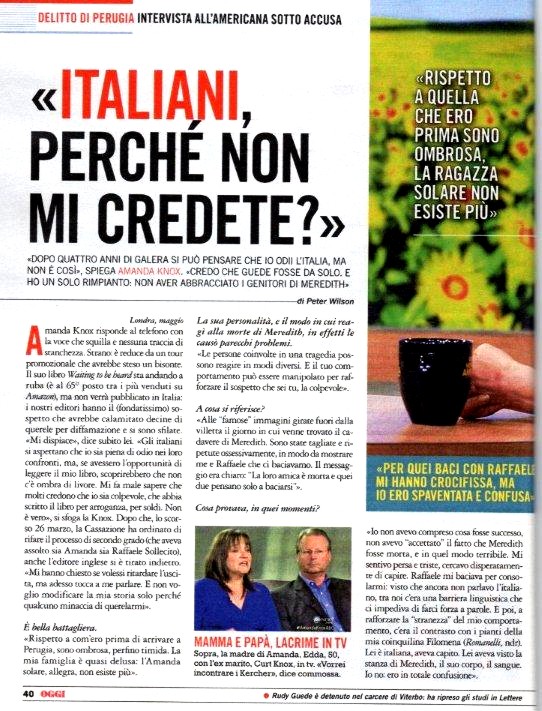

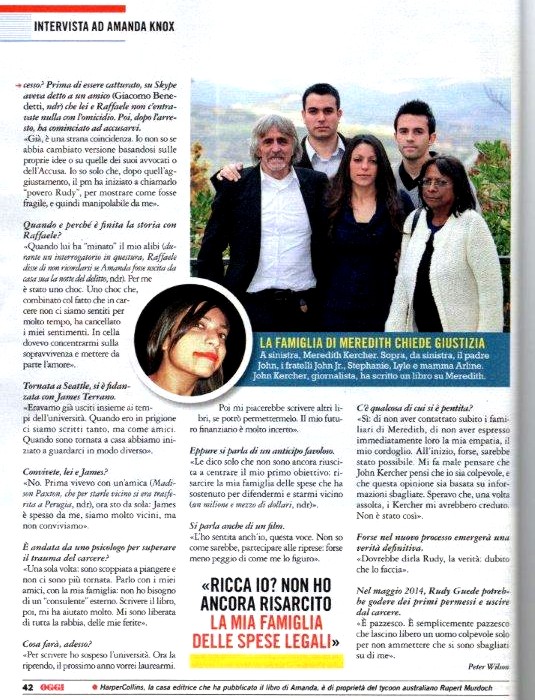
Wednesday, May 01, 2013
A Welcome To New Arrivals: A Second Experienced Lawyer Recommends How To Zero In On The Truth
Posted by James Raper With Kermit
Some Questions
My legal colleague Some Alibi hammers home in the post below that the trial jury were not fools. They decided for guilt unanimously, based on many compelling evidence points.
(1) Do you know how many hard evidence points there are? Literally hundreds. This is a very evidence-heavy case. And at trial in 2009 the prosecution did an excellent job. Between February and June, in about a dozen one-day sessions, they presented an overwhelming case and tied together all the points.
(2) Do you know how many conclusive evidence points are required for a finding of guilt? Just ONE. If it is definitive enough, a single piece of evidence can decide any case. Some Alibi posted a damning footprint example the other day which BY ITSELF could have seen Sollecito convicted in any UK or US court. There are examples too for Knox.
(3) Do you know how many evidence points were discredited during the trial and the anulled appeal? In fact it was NONE. A spooked defence kept well away from the alibi evidence, the cellphone evidence, the computer evidence, the mixed-blood evidence, the obvious crime-scene re-arrangement, and most eye-witness evidence. <
Please click here for more
Tuesday, April 02, 2013
A Growing Number Of Commentators Are Objecting To Overexposure Of The Two Still Accused
Posted by Peter Quennell

We have a series of posts coming up that will describe in detail and analyze the outcome of the Supreme Court.
At least one post will be a roundup of the media. Noticeable this time was less of a tendency to lionize Knox and Sollecito. Some articles and TV reports flipped for Knox, but none did for Sollecito.
And some editors and reporters have weighed in strongly for better balance. David Barrett of the Daily Telegraph wrote this one.
The impending retrial for the murder of British student Meredith Kercher fills many court-watchers with dread, myself included.
Details of the crime are horrific enough. But during the lengthy court processes which we have already witnessed, my discomfort was intensified by the obsession with Amanda Knox.
The photogenic young American, now 25, was convicted and then acquitted of the 2007 murder. She received more sympathy than most suspects who have ever stood in the dock on such a serious charge.
The media pack which followed the Italian trial would often comment on Knox’s apparent frailty; the “stress” she was suffering or whether she looked “pale”. It made me gag.
It’s a difficulty with which any professional and humane court reporter is familiar: how do you keep the victim, who is absent, visible in the very human drama that is a murder trial?
Is it appropriate to pay more attention to the suspect than to the issue at hand; namely, securing justice on behalf of a person whose life has been taken from them? I say it is not, although I can understand why it happens….
When the Italian prosecutors again attempt to secure a conviction for that tragic murder in Perugia we will have to get used to seeing Knox’s face on a daily basis once more. But let’s ensure that Meredith remains at forefront of all our minds.
.
Monday, February 18, 2013
Raffaele Sollecito Now Under Formal Investigation For New Crimes Apparently Unprecedented
Posted by Our Main Posters
Breaking news. The Chief Prosecutor for Tuscany Dr Quattrocchi (above and below) has taken this investigation of Sollecito behind the scenes. Dr Quattrocchi is actually under no compulsion to make any of the Perugia and Rome complaints public before his investigation is complete. He has ordered all documents removed from the public domain. This is specifically to give the defense and their PR no advantage, and to make sure those others in Perugia who are going to complain about being defamed do so without harm.
Overview
This is a contempt of court case as court officials have been impugned. This is Wikipedia’s definition of “contempt of court” under US and UK common law.
Contempt of court is a court order which in the context of a court trial or hearing, declares a person or organization to have disobeyed or been disrespectful of the court’s authority.
Often referred to simply as “contempt,” such as a person “held in contempt,” it is the judge’s strongest power to impose sanctions for acts which disrupt the court’s normal process.
A finding of contempt of court may result from a failure to obey a lawful order of a court, showing disrespect for the judge, disruption of the proceedings through poor behaviour, or publication of material deemed likely to jeopardize a fair trial.
A judge may impose sanctions such as a fine or jail for someone found guilty of contempt of court.
We may now find out much more about the equivalent under Italian law.
When Raffaele Sollecito and Amanda Knox were released at the end of 2011, the prosecution filed a Supreme Court appeal within the allotted period. This automatically meant that Sollecito and Knox still stood accused of crimes until the Supreme Court finally signs off.
Typically Italian defendants in such a legal status get good legal advice, on the lines of “Shut up and keep your heads down. We need to be the only ones doing the talking here.”
Here such advice may or may not have been forthcoming, but the public record strongly suggests it was not. In fact Sollecios entire legal team is credited by both himelf and his shadow writer Andrew Gumbel with helping. This is what Gumbel wrote in his Acknowledgments:
Donatella Donati in Luca Maori’s office gave up many hours to make the official documentation available and to present it all in a cogent order. She’s a largely unsung hero in this story and deserves recognition for her extraordinary efforts on Raffaele’s behalf. Giulia Bongiorno, Luca Maori, and Tiziano Tedeschi answered questions and made comments on parts of the manuscript.
In the same Acknowledgments Sollecito credits the following.
I was lucky to have a crack legal team who showed their devotion to the truth and, in some cases, did not even request payment. The team of lawyers and consultants included Adriano Tagliabracci, Francesco Vinci, Bruno Pellero, Francesco Introna, Giulia Bongiorno, Maurizio Parisi, Daniela Rocchi, Luca Maori, Donatella Donati, Marco Brusco, Aldo Poggioni, Delfo Berretti, Tiziano Tedeschi, and Antonio D’Ambrosio.
Interestingly, Luca Maori has already left Sollecio’s legal team, and all eyes are now on Giulia Bongiorno. Buy plenty of popcorn. Lawsuits could fly between lawyers and family.
Since the end of 2011 Curt Knox’s forces seem to have have gone full steam ahead with their own vilifications of the Italian prosecutors, police, judges, and witnesses - in fact almost anyone who had any role in 2009 in finding them guilty, or came to believe that was a fair finding. Ourselves included.
In late 2012 Curt Knox apparently invited all the most fervent of these attackers to Seattle, including Frank Sforza and Bruce Fischer, as some sort of reward for their legally very ill-advised campaign. Buy plenty more popcorn. Lawsuits could fly here as well.
Raffele Sollecito’s forces in Italy had been a lot more restrained.
But at a stroke, the shrillness of Raffaele Sollecito leapfrogged that of Amanda Knox’s forces, with the publication of his book Honor Bound by Simon and Schuster in English in the UK and US last September,
INSTANTLY the book became notorious in Italy, because excerpts were read out by an Italian reporter in New York on the national television show Porta a Porta. Raffele Sollecito’s father Francesco was on that show, and he was increasingly forced to admit a key claim in the book was invented. It simply never happened. His son made it up.
The false claim by his son that Francesco was made to repudiate - it reappears over many pages - concerned a claimed deal engineered by his family and offered by the prosecution to Sollecito.
The deal he claimed was to roll over on Amanda Knox, and if Sollecito did so, he would be home free.
Following the Porta a Porta show, the book (obtainable on UK Amazon, where many false claims are repeated in the reviews) began to make its rounds in Italy. It took some time before many official parties accused of crimes by Sollecito obtained copies and started to explore their own legal possibilities. They are apparently still far from finished.
At the end of last week, the Chief Prosecutor for Tuscany Giuseppe Quattrocchi received the first official request from Perugia, which is to investigate 12 very serious claims in the book against the prosecution and the legal institutions of Italy. The complaint nominates a number of witnesses.
The Prosecution office of Florence now has a maximum of six months to investigate whether there is a case against Sollecito and other named parties. If so, they will steer it through the hoops of the Italian process.
The potential ripple effects of this appear to us to stretch on and on. They could come to engulf both legal teams (credited in the book with helping) and all of the PR for both defendants. Sollecito’s publisher and shadow writer are specifically named in the complaint
If Amanda Knox is not let off the hook by the Italian Supreme Court late in March (the outcome we consider most likely, given the great strength of the appeal) the smart way for Knox to go in light of this could be to junk all her websites, her book, and her interviews, and throw her supporters under the bus. Plus maybe get smarter lawyers - the aggressive and inexperienced Dalla Vedova does her no favors.
Keeping Amanda Knox’s head out of this deadly new line of fire may be very late - but maybe better late than never.
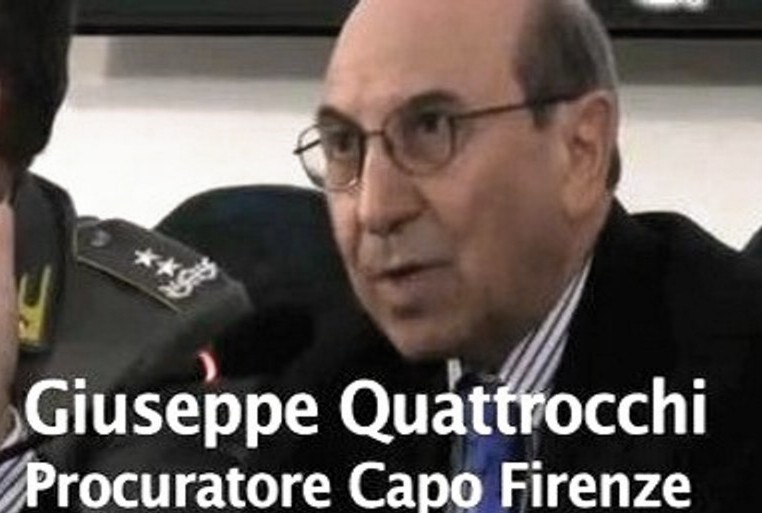
Monday, January 21, 2013
An Overview From Italy #2: Current Perceptions In Italy, Justice Perverters Fail, Mignini Vindicated
Posted by Machiavelli
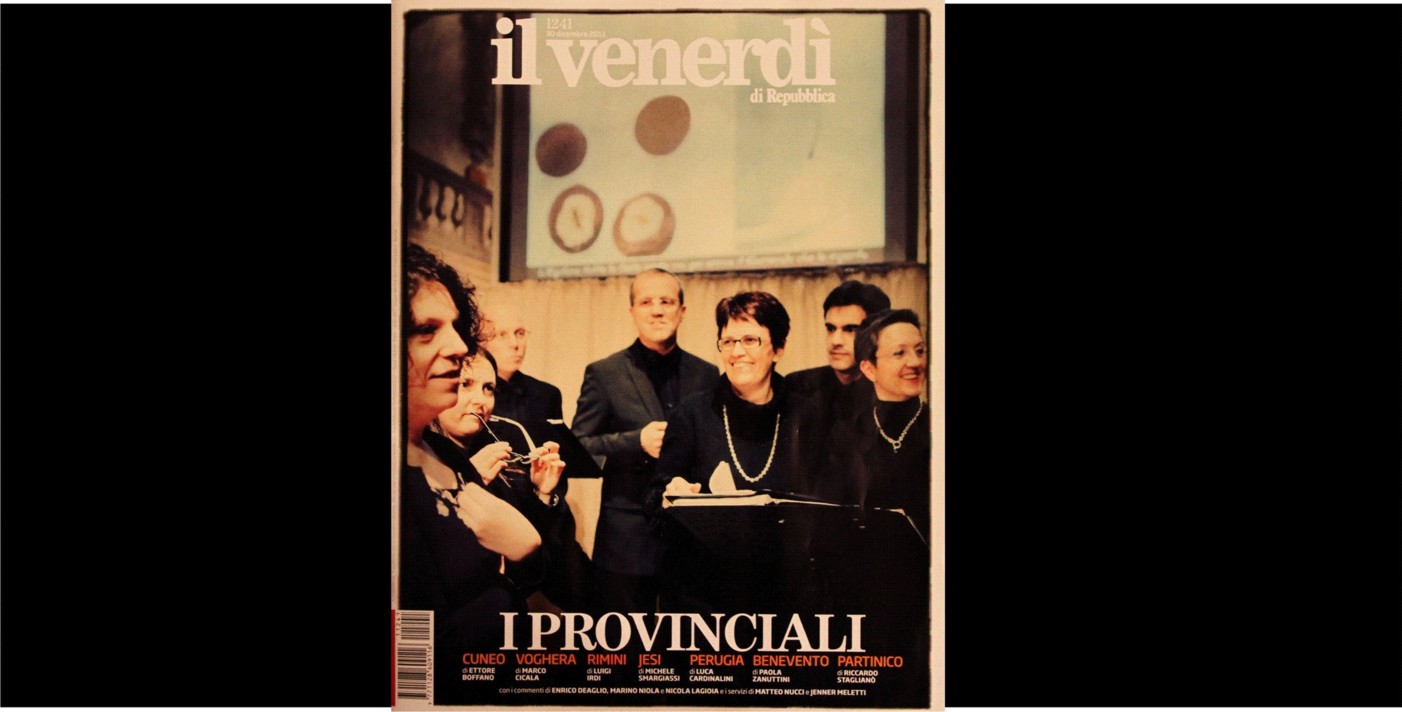
My previous report on the bad news remorselessly building here for the defense was on the Procura Generale appeal to the Supreme Court.
One year ago ““ between the end of December 2011 and beginning of January 2012 ““ there were only rare idle comments in the Italian press about the Meredith Kercher case, more or less sarcastically noting the “suspicious” circumstances of the Appeal trial. I recall how a mention of the topic was dropped into the last number of “ll Venerdì” of 2011.
“Il Venerdì di Repubblica” is the weekly magazine issued together with the newspaper “La Repubblica” (thus probably the most read magazine in Italy).
The cover theme of that week was provincialism ““ or better “the provincials” - the adjective used to assemble a sample of seven little cities (Cuneo, Voghera, Rimini, Jesi, Perugia, Benevento, Partinico), picked from different regions, and taken as examples on the theme, that is stories of “local colour”; what goes on in small “provincial places”. A few characters and stories are brought in to depict the local life of each place, and the voices of local authors adds something about the places.
The article about Perugia (at pages 62-68) was by Luca Cardinalini. In that number of Il Venerdì, having stories of “local colour” as weekly theme, there were shades of ironic tones for each city, often through the voice of local intellectuals. As Perugia is described, the Meredith trial is quickly recalled among its local stories; the reader can’t miss how this is viewed as in connection with another most remarkable feature of the city, that is Masonry.
According to Luca Cardinalini and Enrico Vaime, Masonry is called a “Specialty” of Perugia, like chocolate. Local author Enrico Vaime intends to convey the people’s perception about shady powers existing in the city, about a local environment saturated by plots and informal powers, as something behind recent strange judicial decisions such as the Hellmann verdict and the apparent dropping of the Narducci case. The widespread belief of Perugians that the Public Minister (prosecutor) is the righteous one shines through the words of Enrico Vaime.
Also notice how racism appears to be another key perception about the verdict. Quality media press in Italy has a typical style of understatement. This comment hints that it seems obvious that the Appeal was a racist verdict - and it was “expected” that they would find a way to blame the black one and the outcast.
Some of Perugian “provincialism” seems to include a very narrow localism of Perugian identity: a person from Orvieto is reported to be called “a foreigner” ; but this is because the cultural viewpoint is based on the assumption of a personal knowledge of all people. In among this, there is Vaime’s knowledge about how rooted Masonic tradition and power is in the city, in a scenario of “brotherhoods” and “tribes” (the article includes a photo of the most known “Masonic” monument in Perugia: the gryphon or griffen ““ the emblem of Perugia ““ grabbing a toppled Pope’s Tiara in a sign of rebellion).
The report by Vaime is objectively correct : the concentration of members of Masonic lodges in Perugia is the highest in the world, about 5 times the national average of Italy (which is anyway very high).
In Vaime’s wording decent people in Perugia are ‘Christians’ or ‘Communists’ ““ these are the names he uses to address the main categories he sees as “good” people, two transparent moral systems. He devolves skepticism toward the less transparent allegiances, the murky and informal connections to powers.
I believe these perceptions from one year ago, in this colorful article about Perugia, should be most interesting to the readers of this site.
The first part of the article on Perugia is not that interesting - it speaks mostly about a local character named Ivano Massetti, nicknamed “Savonarola of Umbrian football”, the director (“boss”) of a local TV network and leading showman of his own soccer talk show. I skipped this first part with depictions of local folks, and get to the point at p.66 where the Kercher case is first mentioned.
This is my translation of the article from this point:
[”¦](p.66 line 17):
As Enrico Vaime ““ a 100% Perugian, a writer, and among many other things fiercly provincial ““ already knows: “Only in Perugia do you hear people saying “actually Tizio [random guy] was not a native from Colombella, but from Piccione”, which is three times further”. And when his grandfathers (farther of his father) bearing the same name Enrico Vaime, moved his formal place of residence [to Perugia] from Spello, on the official documents they wrote “emigrated to Perugia and married to a foreigner from Orvieto”.
The roots are extremely deep. “Still today” Vaime says “when I say to my family “we go back home”, I mean here, in Perugia, where I have not owned a house for decades. And I still call the roads and shops with the names they had when I was a child, even if now the owners are foreigners, from Shangai or, as I say, from Terni”.
Vaime is cross with the bad reporters who described Perugia, in the Meredith murder case, as a capital of corruption and vice: “An invasion of charlatan journalists who, as they believed they were visiting a remote and lost province, they painted it as a sort of Chicago on the Trasimeno Lake”.
[The fact] that no Perugian was involved in that sad story, to them that was an irrelevant detail. And the trial ended just the way many Perugians expected: a black guy first wrongly put in jail, another black one convicted, the two white, good-looking, wealthy and well defended young people, free.
So it was that the Public Minister Giuliano Mignini became a target. He’s a Perugian whom the Perugians know as the dominus of the other judicial case ““ this also is, yes, entirely local ““ about which everybody talks and knows, but always in a low voice: the death of doctor Francesco Narducci, the one suspected of having ties to the crimes of the Monster of Florence. From the judicial point of view that was - by half ““ just another hole-in-the-water [a failure] for which some critics have hastily put the blame on some alleged lunacy of the public minister.
But”¦ however”¦ meanwhile, this [Naducci] corpse-swap was indeed found to have been for sure, a kind of unique case in the criminal history of the country. And, for what concerns the recent acquittals of those characters involved in this death, well, after almost a year and a half we are still waiting for the verdict motivations. All of the suspects were esteemed high-class professionals. That’s a perfect mix of strange deaths, sex, lead-astray investigations, and Masonry; this is in the city with the highest number of Masonic lodges in Italy.
Vaime sighs: “Masonry is something alien from me, but I have many friends who are in it. In Perugia it works as a compensation chamber for various powers, but also as an effort for the surge of the spirit to many decent people. Masters, masons and “33”, but all of them decent Perugians”. Masonry is considered a local specialty, just like the bruschetta or the Etruscan arch.
“One day you find out that that mediocre employee of your acquaintance, or the one who performed an incredible career in the public administration or in politics, is a “˜son of Horus’. Then you either laugh, or you slap yourself on the forehead just like saying to yourself “Wow! [how could I ] think about it!”. “That travet* [*a generic mediocre opportunist employee], too”
Vaime says “to me it is a strange Perugian, with little interest for the Egyptian god compared to his covet for entering inner circles of a certain world. Their internal motivation is “I want to see how the lords sit at the table”. But in there [Masonry], you see, there are also good Christians and good Communists; as has always happened in this province, which has the art of living together in its genes”.
[”¦. ]
This month ““ Jan 2013 ““ the Italian press returned to the topic of the case again in a few brief articles. This time it was because of Sollecito’s book.
After Maurizio Molinari’s report from New York on the book in September, and the busting by Bruno Vespa on Porta a Porta of Francesco Sollecito, who ended up openly contradicting his own son’s statements, another hint appeared in the local press about what is cooking up backstage.
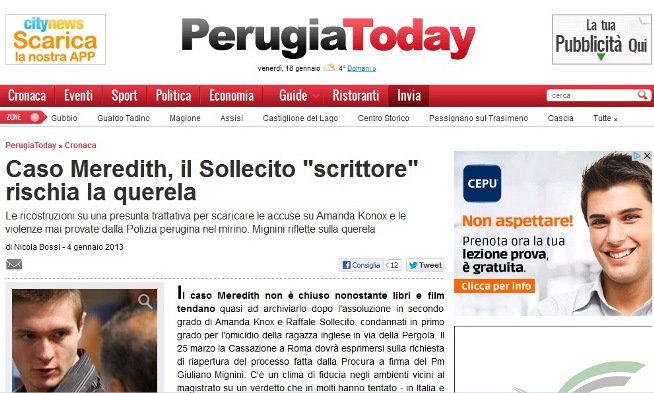
This article in Perugia Today has a neutral take, but the same understatement and kind of vagueness as it anticipates that something very likely will happen.
What I find most delightful is the quotation marks in the title around the word “author” ““ journalist Nicola Bossi doesn’t believe for a moment that Sollecito actually wrote the book:
Meredith Case: “author” Sollecito at risk of criminal lawsuit
The recounts about an alleged negotiation in order to pin the main charges on Amanda Knox, and unproven violence by the Perugia Police are under target. Mignini is considering criminal lawsuit.
Written by Nicola Bossi ““ Jan 4. 2013
The Meredith case is not closed, and this despite books and movies almost tend to drop it after the acquittal in second instance of Amanda Knox and Raffaele Sollecito - who were convicted in first degree for the murder of the English girl that took place in Via della Pergola.
On upcoming March the 25th the Court of Cassation of Rome will have to decide on the request for a re-opening the trial, submitted by the Procura with the authorization of Public Minister Giuliano Mignini.
In the environment of the magistrates there is confidence about a [guilty] verdict that many ““ in Italy and in the USA - have heavily attempted to discredit. But from the same environments around them, they talk about a greatly serene Mignini making assessments about the next strategic moves, following the attacks directed against him ““ and against those in Law Enforcement who cooperated with him ““ contained in the book by Raffaele Sollecito.
An upcoming criminal defamation lawsuit is becoming more and more likely every day, especially about some particular paragraphs. The material published by Sollecito has already resulted in discussions and clamor above all about claimed negotiations [with the prosecution] aiming to shift the blame onto Amanda alone, to be rewarded with his immediate release.
But there are also accusations against the Police about violence during his interrogations. “If you dare get up and walk, I beat you up in a bloody pulp and I kill you. I leave you in a pool of blood”. This is what you read in the book “˜Honour Bound’ issued in the US, as what Sollecito attributes to the Perugian officers.
“They wanted me to lie so they could frame Amanda”: this is the premise of the claimed negotiations claimed to indirectly involve Mignini too, which he always denied. Allegedly this would have been enough to get [Sollecito] out from prison soon, leaving the American woman in trouble.
So, these are grave accusations which Mignini apparently does not intend to let go unpunished. The criminal lawsuit is likely to be filed earlier than the date of Cassazione [25 March].
Another small piece of news is this article below published in Leonardo and written by Valentina Cervelli:
It seems basically a “commented” version of the Perugia Today article. Cervelli adds a few polite lines on her own thoughts in this piece, published on the Bbooks page of Leonardo,it; this is my translation:
Is Raffaele Sollecito going be sued soon for “Honor Bound”?
By Valentina Cervelli - 6. Jan 2013
Are there troubles in sight for Raffaele Sollecito? His “Honour Bound” book is going well in the United States in terms of sales, but here in Italy it might be soon result for him in a lawsuit for defamation by the Law Enforcement forces and by the Public Minister Giuliano Mignini.
As we know already, in Honor Bound ““ My journey to hell with Amanda Knox and return Raffaele Sollecito has reconstructed the whole judiciary story from his point of view, telling in his autobiography what [he says] is his own truth.
On March 25 Cassation in Rome will decide on the [prosecution] request for the re-opening of the trial submitted by the Procura authorized by Giuliano Mignini, after the acquittal in the second instance of the two main accused, Sollecito and Amanda Knox.
The young woman has returned back to her country and we bet it’s going to be difficult, if not impossible, to get her back in our country even in case of retrial after Cassation and a possible conviction. But lets leave aside this possible dispute and lets focus on the book. In Raffaele’s book Mignini is iimplicated because he reportedly comes out discredited. In the material published by Sollecito in his book he even talks about alleged negotiations in order to blame Knox alone, obtaining in reward a quick release.
And what about the allegations of Police violence during interrogations? Of course we don’t get into the merits, but it seems obvious that parties that may be considered offended would tend to launch a counter-attack to defend their dignity and their work. At the moment no lawsuit has been submitted. But with much probability that will be done before the decision of Cassazione.
By now we can only wait for the publishing of the book in our country, in order to assess with our minds what Raffaele Sollcito has written and the “hot” material published in his made-in-the-US autobiography.
By the way; one thing Valentina Cervelli might get wrong is the purported good sales of Sollecito-Gumbel’s book.
The Amazon.com site is reliable as quick indicator of a product’s success; the price of a new copy of “Honor Bond” on Amazon.com is now $ 3.51 (last week it was 3.76; the cover price is $ 24). It suggests sales are not quite as expected. The drop speed is significant if you consider that the book has been out for only four months.
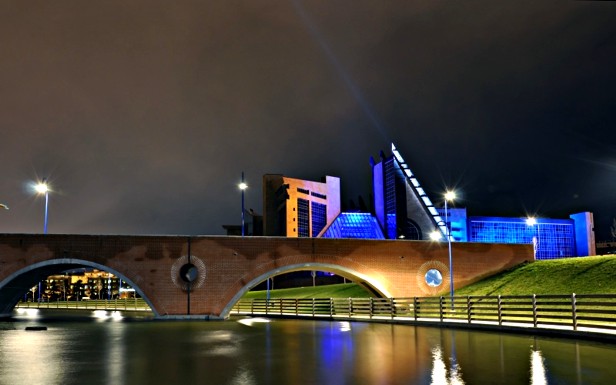
[Above: the Florence Palace of Justice]
While many honest magistrates seem to be working in Florence, there is still some strange behavior by one or two people in the Florence prosecution office.
Iin particular by the chief prosecutor there were some unexplainable decisions. As people reading this site know, Giuliano Mignini and Michele Giuttari were convicted (of some of the charges) in the first degree trial in Florence.
The motivations document was disconcerting because: besides the proof of their innocence on the main charge, what was described as the evidence on the remaining charge constituted extremely weak and vague arguments for what was claimed about Giuttari, while they were totally non-existent about Mignini.
In the second instance appeal as we know the court completely crushed the trial case.
The case against them collapsed not because of a technicality, as the FOAs falsely claimed. In the figment of their imagination the Knox supporters erroneously thought that the Florence court had an “option” to overturn the case, to find Mignini and Giuttari innocent, but that they instead decided to pass the judgment on to some other tribunal.
The pro-Knox believers are probably also ready to believe blindfolded that there was some kind of evidence against Mignini.
The Knox believers are wrong. What in fact happened in Florence is something almost unique in a judge’s career. The first remarkable event was the decision by the Florence court of nullifying the first degree verdict. They did not simply overturn the verdict (neither change, or “reform” it as we say) since an overturning would imply acceptance that a previous verdict actually existed and was legitimate.
The cancellation was in fact an in limine act about the validity , which does not require an assessment about it correctness. The court went way beyond. In fact they nullified the whole trial, not only the previous one in terms of judgment, but also the preliminary hearing, and the indictment; and even the request of indictment.
It is a legal outcome not comparable to a simple change or overturning because it is a ruling that the whole proceeding was illegitimate from the very roots. The investigation itself of Mignini and Giuttari was declared illegitimate.
If elements were found for the opening of an investigation, the prosecutor would be entitled to carry on their duties, though the investigators should be from another territory. This is important because the Florence court found evidence that people from the same office were involved in cases against Giuttari and Mignini, both as offended parties and as prosecutors.
Because of a basic conflict of interest, the local prosecutors were incompatible and the Procura of Florence had no jurisdiction. Not even Genoa would be compatible.
Florentine prosecutors therefore had no right to bring cases against Mignini and Giuttari. The investigation files now must now be sent to the competent jurisdiction ““ where they should have been sent from the beginning ““ which is Turin; there other legitimate prosecutors will decide if and how there is anything to investigate about, and if there are any charges to bring against anyone. The Florentine trials should have never taken place. The court ordered that the legitimate investigators are the Procura of Turin.
In addition, they also ruled that the court of Florence would be an incompetent jurisdiction in any further possible case that stems from that investigation: since the competent prosecution is Turin, in case elements for the indictment of anyone for any charge are found, in the future, everything should go to a court in Turin ““ this, only if there will be any charge to bring to court .
This decision in Florence was a total debacle for the Florence prosecutors. It is in fact “politically” much worse than an overturning of a verdict. It is not just a like a different conclusion on the merit, it is the decision to take away even the investigation from them, a kind of implicit censure of their work as highly illegitimate.
But at this point in the procedings, something even worse and even more strange happened. The Procura of Florence did something even more unusual, in fact unprecedented as far as I know.
Apparently the Florence prosecutors are not happy at all to pass the investigation file on to Turin. For some reason they seem instead to want to do unnecessary and irrelevant hard work instead. The Florentine prosecutors impugned the decision and revisited this at the Supreme Court against the Florentine judges.
This step is almost unheard of because the decision of the Florence appeal court is of a type that manifestly cannot be impugned at the Supreme Court. The recourse is obviously going to be declared inadmissible. If that submission was done by a private citizen, they would get a heavy fine for that.
Here it is a power in the Florence judiciary branch making this inadmissible move; for unknown reasons.
I’d like to know the real motive behind the latest Florence move, the only effect of which can be a waste of time (and money), a delay, of at least one or maybe two more years, which only makes the failure of the whole proceeding against Mignini and Giuttari more likely due to lapse on an expiration terms.
I say “I’d like to know” but in fact one motivation stands out as obvious: the whole proceeding against Giuttari and Mignini, from the first bringing of the charges at the lower courts, appeared as having a wasting of time among its purposes.
One practical effect - maybe a practical purpose - of pushing the charges against Mignini, was taking the file about the Monster of Florence case links with the Narducci case away from Perugia. By this move, the Florentine prosecutors managed to factually put their hands on the Narducci-MoF file and remove it from the investigating powers in Perugia.
Another effect of this was delay. Now this latest move looks as if its purpose were to delay, as much as possible, the transfer of the legal documents to Turin.
What is the ultimate event that, by all this, they seem to be seeking to delay? I can’t know for sure, I can only guess; in fact, I have only one answer, which also stands out as something obvious for those who know a bit of the backstage:
Giuliano Mignini is not an ordinary magistrate, he belongs to the Anti-Mafia Territorial Division of Umbria, and recently was selected for a further promotion by the Supreme Council of Magistrates.
In fact what is delayed is the advancing of Mignini’s career: in fact he has been already promoted to a directive function; but, by the rules, his taking the post was frozen while awaiting the outcome and conclusion of the Florentine prosecution.
Prosecutor Mignini is de facto already functioning as a prominent Magistrate in Perugia and considered as such; but formally he has not been given the directive power. Several people ““ among them Spezi and a number of his journalist friends, but possibly also other much more important people too ““ are likely not at all eager to see Mignini awarded further power.
About the latest endeavor by Raffaele Sollecito, who became liable for criminal defamation by writing false allegations about Mignini and others in his book, I expect - as logically unavoidable ““ that several powers and subjects will basically have no option but taking legal against him.
There will be a strategic necessity to doing this in order to prevent extradition issues in the future, but also, above all, on principle, because Sollecito made false claims about public institutions that needt to have their names cleared. Considering the kind of allegations against the judiciary as an institution, and considering that Mignini is a judge of the Anti-Mafia Division, this is the kind of lawsuit that I see as likely to be submitted on a national level, in Rome.
If that is the case, it would not be the only strange thing that the courts of Rome will deal with.
It seems like there is a kind of “curse” on proceedings related to the Narducci case. All sections of the Supreme Court which have been asked seem to have attempted to declare themselves “˜incompetent’ about re-opening the cases related to the Perugian doctor. The Cassazione is a huge office with a hundred judges working there, but maybe not so many of them are eager to deal with this case.
This could be only a coincidence. It only brings up to my mind, through a free association of thoughts, a more generic question ““ a personal question of mine ““ that is whether the words “Masonry” and “Politics” have an echo in Roman corridors too.
*****
Finally I want to add another significant piece of Italian news.
The news a week ago was that the Procura of Florence is investigating a possible corruption/mafia plot involving construction enterprises and politicians that revolves around the building of a new high speed railway in Florence.
Some 31 people are being investigated and among them is the former governor of Umbria. A huge drilling machine ““ nicknamed the “Mona Lisa” ““ used to dig subway tunnels in Florence was sequestrated by the Procura.
In the last couple of years Perugia’s prosecution office had a main role in fighting political corruption, but it seems that the Florence Anti-Mafia division is also active, just as it was in the times when the prosecutor Vigna worked with them.
Vigna was the one who first evolved the “secret sect” scenario in the Monster of Florence case, raising unexpected problems among the Procura staff.
Saturday, January 12, 2013
How Much To Place Blame On Guede? IMMENSE Headache For RS & AK Teams
Posted by Cardiol MD

[Photo by Andrea Vogt as in December 2010 Supreme Court decides that Rudy Guede didnt act alone]
Zero To 100% Guede Was Claimed Sole Attacker
On a scale of 0% to 100% how much of the blame for the crime against Meredith has been heaped on Rudy Guede?
Well, it certainly varies. In trial court and first-appeal court it was never ever 100%.
Seemingly very scared of the harm Guede could do to their clients, if they provoked him into telling all, defense lawyers have acted consistently since 2008 and more-so since December 2010 as if they walk on eggshells around him.
In fact among the defendants and their teams only ONCE was Guede ever blamed 100%.
Sollecito’s bizarrely-titled Honor Bound 2012 book, the factually unchecked one, which now is causing him and his defense team so much trouble, was the first instance ever among those accused to try to blame Guede for the crime 100%.
Our next post will look at the categoric claims against Guede by whoever wrote that book. Meanwhile, here and now, let’s start at the beginning.
Commencing from when they were arrested, Amanda Knox pointed decisively at a black man, but of course she pointed at the wrong one: Patrick Lumumba. Make that 0% . Not long after they were arrested, Knox and Sollecito were strongly questioning the role of one another. So 100% against each other, but still a zero against Mr Guede.
In his messages from Germany Guede blamed two hasty intruders though he had no choice but to say he was there. Perhaps 33% at this point. After Guede was captured, Sollecito implied that they were at the crime scene together because he was worried that Guede would implicate him. Make that 50%.
At Guede’s short-form trial In October 2008, Judge Micheli blamed Guede 33% too. In sending Knox and Sollecito to full trial he dismissed the lone wolf theory (never really to be revived in court again) and he tentatively believed the evidence pointed to their being equally guilty.
In fact Judge Micheli tentatively blamed Knox for instigating both the attack on Meredith and the rearrangement of the crime scene. In effect he allocated 50% of the blame to Amanda Knox and 25% each to Guede and Sollecito.
Throughout trial in 2009 the Knox and Sollecito defense teams seemed to take great care not ever to blame Guede 100%, perhaps because (for murky reasons not made public) Rudy Guede had refused to testify against their clients.
Judge Massei assigned Guede 33% of the blame as he concluded that Guede had initiated the attack but that Knox and Sollecito had wielded the knives and that one of them had struck the final blow.
During trial and thereafter, the defense lawyers for the three were often on Italian TV and as our main poster the Italian lawyer Cesare Beccaria exhaustively charted in a four-part series, each “gently” blamed the other two.
We can assume that is either 33% or 50% but never more than that.
On February 24. 2011, in the Supreme Court report, on its rejection of Guede’s final appeal of his sentence for involvement in killing Meredith, blamed Rudy Guede and two others equally. Some 33% of the blame each.
The Supreme Court relied upon three facts: the physical evidence of Guede’s presence at the flat, Guede’s actual admission of his presence, and Guede’s implicit admission of shared-guilt in his documented Skype InstaMessage to Giacomo Benedetti on Nov. 19, 2007 (“I was scared that they would say I was the only guilty person”).
In a nutshell, the situation at the start of the Sollecito and Knox appeal before Judges Hellmann and Zanetti in 2011 was this:
- The Supreme Court had decided that Rudy Guede acting ALONE could not have attacked Meredith with several knives over an estimated 15 minutes, left so little physical evidence upon her, staged the break-in via the absurd route of Filomena’s window while leaving zero DNA in her room, placed Sollecito’s DNA on Meredith’s bra clasp, engineered several traces of Knox’s and Sollecito’s footprints outside the room, and placed the mixed DNA of Meredith and Knox in several different locations outside Meredith’s locked door.
- But there remains zero evidence that perps two and three which the physical evidence strongly pointed to were anyone other than Knox and Sollecito. There’s really not one speck of hard evidence to the contrary. Defenses somewhat desperately tried to engineer some at first appeal from the seemingly perjured testimony of jailbirds Alessi and Aviello and some smoke-blowing over the DNA testing, but in terms of HARD evidence came up empty-handed. Alessi did a meltdown on the stand, while Aviello turned completely cuckoo, and Judges Hellmann and Zanetti had to invent arguments frantically to dig Knox and Sollecito out of that hole.
I have done a series of posts (to be read from the bottom upward) on the Hellmann-Zanetti outcome covering many other aspects of their strange arguments.
Back in late 2010 some of us at TJMK were impressed at the alacrity with which Judge Hellman selected Conti and Vecchiotti.
We were thinking that “he had already thought it all out” [we seem to have got that-much right], and that he was “being prudently responsive to the legal and political pressures bearing down on him, and knows the ruling also calls the defendants’ bluff.”
I had posted that the defenses of Knox and Sollecito seemed to be trying to exclude evidence that they themselves tried to destroy, essentially on the grounds that their destructive attempts failed to destroy all of it, and left behind only some of it. Their argument had boiled down to whether the disputed DNA evidence is more unfairly prejudicial than probative.
It was my opinion that because it was the defendants’ deliberate conduct that nearly succeeded in extinguishing all their DNA, any US and UK courts would admit this highly relevant evidence, and let the participants duke out its fairness, in open court, in front of a jury.
I had thought that was what the Massei Court had already done, and was what the Hellmann/Zanetti court was then doing. The Hellmann/Zanetti court was doing that - but that was not all it was doing, as we now know and regret.
I had believed that the defendants would bitterly regret their petition for such DNA Expert-Opinion Review. We should know in March 2013 if they regret it at all, let alone “˜bitterly’. So far they may not, but Sollecito’s current venture into special-pleading journalism in his book seems likely to accelerate their journey to a bitter and regretted destiny.
We were less impressed with how Judge Zanetti started the appeal hearings.
To his eternal discredit Judge Zenetti uttered words to the effect that “the only thing that is “˜certain’ in Meredith’s case is that Meredith is dead.” Nothing else. In effect, illegally promising a whole new trial at appeal level - very much frowned on by the Supreme Court.
Unless the word “˜thing’ is a mistranslation, that is not the only thing that was already certain in Meredith’s Case; Many Things were then certain in her case.
For example, it is certain that the first-ever documented references to Meredith’s scream just before she was killed had already come both from the mouth of Amanda Knox herself, and from the hand of Amanda Knox, in the case of her contemporaneous personal hand-written notes.
Guede, himself, had certainly already made a documented reference to Meredith’s scream.
It was also certain that Guede had made documented references to his actual presence when Meredith screamed.
Some of these already-certain facts inconveniently undermined Hellmann’s and Zanetti’s already-assumed conclusions, so they then proceeded in-turn to undermine the “˜reliability’ of those facts, e.g. “˜it is not certain that the scream was Meredith’s scream; it could have been someone-else’s scream’; or even Amanda’s scream?
The Massei court had exhaustively presented the evidence from all sources in their conclusion that Knox and Sollecito were the ones who shared Guede’s guilt. But Hellmann/Zanetti then contradicted ALL the previous finders-of-fact with regard to Guede, essentially using five ploys in arguing:
- That Guede was Unreliable: “for example, in the questioning before the Prosecutor, he denies being known by the nickname of Baron, “¦.so as to result in a version completely incompatible with the reality of the facts as perceived and heard…” [Is that ever giving birth to a mouse?], and
- That the Supreme Court had “held Rudy Guede to be an Unreliable person”, and
- That “therefore, among the evidence against the two accused, the testimony given at the hearing of June 27, 2011 by Rudy Guede cannot be included because it is Unreliable, nor can the contents of the letter written by him and sent to his lawyers”, and
- That concerning Guede’s documented Skype InstaMessage to Giacomo Benedetti on Nov. 19, 2007 “”¦ the contents of the chat between Rudy Guede and his friend Giacomo Benedetti on the day of November 19, 2007, also listened to by the Police, can be considered in favour of the two accused”, because “he would not have had any reason to keep quiet about such a circumstance,”
- And that “So, in the course of that chat with his friend….. Rudy Guede does not indicate in any way Amanda Knox and Raffaele Sollecito as the perpetrators…..” and “.....he would not have had any reason to keep quiet about such a circumstance….. he being…. certainly the perpetrator….. of the crimes carried out in via della Pergola, that if Amanda Knox and Raffaele Sollecito had also participated, that he would at that moment have revealed this to his friend.”
So, summarising Hellmann and Zanetti, they have absurdly argued a contradiction:
- Because of Guedes notoriously unreliability, the public evidence in which he did accuse Knox and Sollecito cannot be considered as evidence of their guilt, but
- In spite of Guede’s notorious unreliability, because Guede did not accuse Knox and Sollecito in a private conversation this must be considered as conclusive evidence of their innocence.
We are not the audience to which Dr Galati’s appeal against Hellmann and Zanetti to the Supreme Court is directed. Most of us probably have some difficulty with its legalese, translated into English, so bear with it.
Dr Galati’s appeal against Hellmann and Zanetti refers to Guede’s documented Skype InstaMessage to Giacomo Benedetti on Nov. 19, 2007 as follows:
The Hellmann/Zanetti court, “has”¦ made “¦. completely anomalous use of the Skype call, accepting it for the time of Kercher’s death, but not for other circumstances which are also extremely relevant for judgment purposes, but which have been totally ignored.
In fact, in the call, Guede recounts having heard Meredith complaining about her missing money and of her intention of asking Ms Knox, with whom she had quarrelled, for an explanation (p. 10 of the call [transcript]), of having seen Meredith look in vain for the missing money in her drawer (p. 18), then of having seen Meredith look, still in vain, for her missing money in Amanda’s room (pp. 18-19 of the call [transcript]), and of having heard a girl enter the house, who could have been one of the roommates, thus Amanda (p. 11 of the call [transcript]), while the Ivorian found himself in the bathroom, just before hearing Meredith’s terrible scream which would have caused him [59] to exit the bathroom, about five minutes after the girl’s ingress (p 12 of the call [transcript])”... .
The Court has, in practice, without reason thrown the responsibility onto Guede for throwing the rock and clambering in (see pp 121-122 of the appealed judgment): in the same Skype call, Guede, however, repeatedly denies having seen the broken window in Romanelli’s room during the whole time in which he was in the house at Via della Pergola on that evening (pp 8, 20, 34 of the call [transcript]). Not only that: Rudy Guede also said that he was at Knox’s many times”› (pp 88 of the call [transcript]).
If the Court held the Ivorian citizen to be sincere in the tele-conversation with his friend Benedetti, then why not also believe him when he denies having broken in, or when he recounts Meredith having it out with Amanda, or when he says that he had been at the latter’s place many times”›?
Dr Galati’s appeal to the Supreme Court argues that the Hellmann/Zanetti appeal judgment, apart from being manifestly illogical, is manifestly contradictory with respect to the contents of the case file referred to (Article 606(e) Criminal Procedure Code). Here is what it says about their tortured interpretations of Rudy Guede.
And in the Skype call with Benedetti, intercepted unbeknownst to him, there emerge circumstances that confirm Guede’s court declarations. The Court takes the Skype call with his friend Benedetti into examination, valuing it “šin favour of the two accused”› both for what it does not say and also for what it does say, and this it does building from one, not only unexplained, datum but which would have taken little to deny: since Rudy was outside of Italy, he was in some sense safe”› and thus could well have been able to tell the whole truth (p 40 of the judgment).
Not in the least does the Court depart from the presupposition that in this call Rudy would have been telling the truth and, because in this call he would not have named the current defendants, these have got nothing to do with the homicide. The Court does not explain, though, that even in this call Rudy was tending to downplay his responsibility and, if he had named his co-participants, that would have easily allowed, by means of investigations and subsequent interviews, the bringing out of his causal contribution and of his responsibility.
[91] Of the things said in this Skype call, the Court seems at one moment to want to value the chronological datum from 9:00 PM to 9:30 PM to affirm that this would therefore have been the time of death of Meredith; successively, though the appeal judges, following the principle of plausible hypothesis, in relation to the outgoing calls on the victim’s English handset, have moved it to 10:15 PM, but they have not altered the reliability of the time indicated by Guede.
In truth, during the course of the conversation, Rudy recounts having heard Meredith complain about the missing money and of her intention to ask Knox, with whom she had argued, for an explanation (p 10 of the call); of having seen Meredith look in vain for the missing money in her drawer (see p 18); of having seen her search, again in vain, for the missing money in Amanda’s room (pp 18 and 19 of the call) and of having heard a girl enter the house ““ who must have been one of the flatmates, thus Amanda (p 11 of the call), ““ while he was in the bathroom, a little before hearing Meredith’s terrible scream which would have induced him to exit the bathroom, about five minutes after the ingress of the girl (p 12 of the call).
And also, on the subject of the break-in in Romanelli’s room ““ thrown without explanation onto Guede’s back (see the judgment being appealed from, at pp 121 and 122) ““ can remarks by the Ivorian citizen be found in the transcription of the intercept. Guede repeatedly denies having seen the broken window in Romanelli’s room for the whole time in which he was in the house at Via della Pergola that evening (pp 8, 20, 34 of the call).
If the [Appeal Court] had held as reliable what Rudy narrated in the Skype call relating to the time in which Meredith was killed, it supplies no reason at all, on the other hand, for why it does not believe him as well when he denies [92] having committed the break-in or when he recounts the quarrel of Meredith with Amanda.”
None of this changes my own beliefs that there are even many more things in evidence that are “˜beyond any reasonable doubt’. For example:
- It is beyond any reasonable doubt that Meredith was restrained by hands other than the knife-wielding hand(s); and that Meredith was restrained by the hands of two, or three persons as she was killed.
- It is beyond any reasonable doubt that steps were taken to clean away smears made by Meredith’s blood in the place where she was killed, and tracks of Meredith’s blood transferred by her killers to other places.
- It is beyond any reasonable doubt that steps were also taken to simulate a break-in that never-was.
In the next post, we examine Dr Galati’s appeal further and the strident claims against Guede made in Sollecito’s own book which contradict some of the positions of HIS OWN LAWYERS. Note that Dr Galati has argued in the appeal that it was ILLEGAL for Hellmann and Zanetti not to have taken the Supreme Court’s ruling on three perps fully into account and having innored it or brushed past it.
Verrrry tough situation for defense counsel to be in.
Thursday, December 20, 2012
Have The Raffaele Sollecito Defense Team Of Bongiorno And Maori Now Gone AWOL?
Posted by Peter Quennell
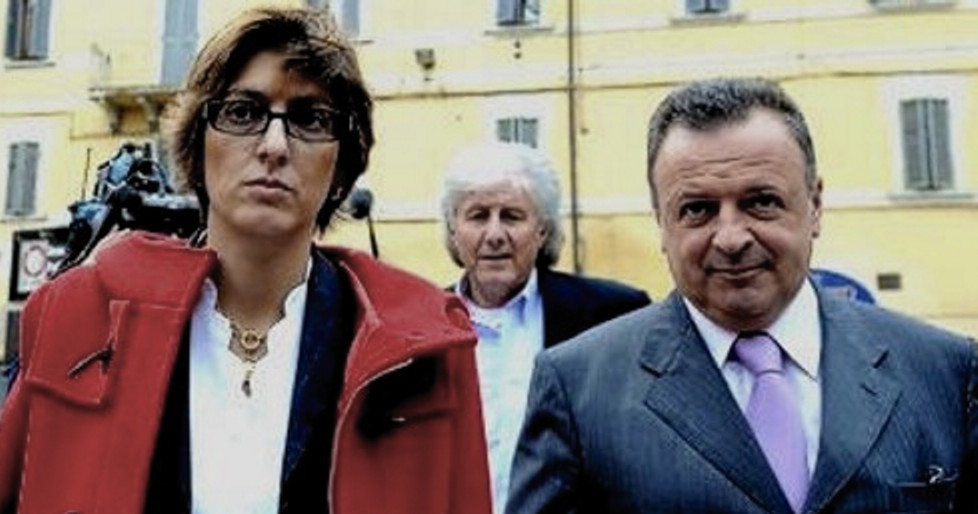
No word from the Sollecito or Knox defense teams since Sollecito’s book kneecapped them, along with Amanda Knox and Sollecito’s own dad.
The lawyers are nicely credited (see below) in the book as eager helpers. They must just love that. Whoever feels that Sollecito defamed them may be able to require that those credited by Gumbel & Sollecito be cross-examined.
We do look forward to the possibility of seeing Giulia Bongiorno and Luca Maori (images above) sweat it out. Along of course with the “boundlessly generous” Steve and Michele Moore, and all those super-diligent publishers.
And of course Sollecito’s own father and sister, who were dedicated to “getting every detail just right”.
Of course the Sollecito book then turned around and whacked them. Maybe that is why Sollecito’s dad already admitted on national TV that his son’s claim that a prosecutor broke the law was simply made up. Not easy, being Pappa Sollecito.
Acknowledgments from page 266 of Sollecito’s book:
Andrew Gumbel would like to thank Dana Newman, who made a crucial introduction at the start of this project, the indefatigable Sharlene Martin, the ever gracious Gail Ross, the boundlessly generous Steve and Michelle Moore, my favorite pugliese Anna D’Elia, Peter Popham, Robert Adams, and of course the rocking, super-talented team at Simon & Schuster/Gallery who were never less than a pleasure and kept me sane against a tight deadline. Thank you, Jen Bergstrom, for believing in this book from the get-go, thank you Lisa Rivlin and Alex Lewis, and thank you, Trish Boczkowski, for your brilliant editing and infectiously good company. That’s amore!
This was a group effort all around. The Sollecito family, not just Raffaele, opened up their lives and their souls with remarkable candor. Thank you, in particular, to Francesco and Vanessa for days of fascinating conversation, for your dedication to getting every detail just right, for compiling exhaustive time lines, and making sure that material reached me promptly. Donatella Donati in Luca Maori’s office gave up many hours to make the official documentation available and to present it all in a cogent order. She’s a largely unsung hero in this story and deserves recognition for her extraordinary efforts on Raffaele’s behalf. Giulia Bongiorno, Luca Maori, and Tiziano Tedeschi answered questions and made comments on parts of the manuscript.
Wednesday, December 12, 2012
Simon & Schuster Seem To Be Seriously Rattled Over Lack Of Due Diligence On Sollecito’s Book
Posted by Peter Quennell
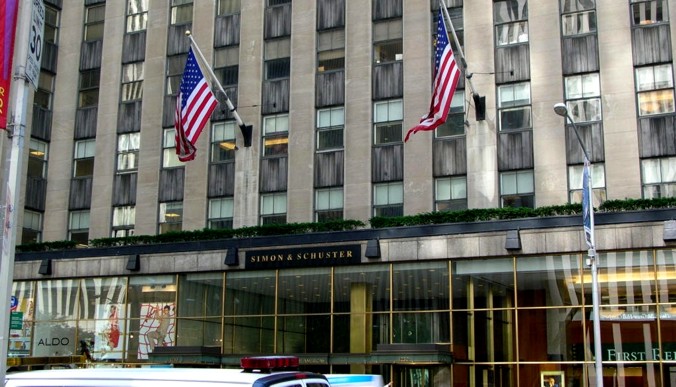
See this emailed exchange which took place late today.
What Simon & Schuster’s agent is complaining about was a chronological reordering (behind the scenes and not linked to from the front page) of these many corrections here. Our Kindle and hardcover copies were legally purchased. Simon & Schuster put about 1/4 of the book on the front of their own website, and Google Books also carries about 1/4 of the book to read free.
Admittedly, our corrections may have been quite a shock. However, we didnt cause the book sales to tank. All of our past posts on Raffaele Sollecito’s book can be seen here.
*******
Mr Eraj Siddiqui
119 South B Street Suite A,
San Mateo, CA 94401
Dear Mr Siddiqui
Thank you for your “Verified DMCA Removal Request from Attributor” copied below.
The book you refer to appears to contain up to 30 instances of criminal defamation under Italian law and literally hundreds of wrong and injurious statements that are hurtful to many fine officials in Italy.
We have full legal rights to point out the myriad mistakes in the book. In fact a defamation of a prosecutor in the book has ALREADY been admitted on Italian national TV by the writer’s own father in Rome.
That Simon & Schuster apparently failed to do their legal and factual due diligence on the book prior to publishing seems to us to be absolutely nobody’s fault but their own. They are hardly new at this game.
Nice try, but sorry, no cigar.
Peter Quennell
*******
Dear Sir/Madam,
I certify under penalty of perjury, that I am an agent authorized to act on behalf of the Rights Holder identified below, the owner of certain intellectual property rights in the Work(s) identified below.
I have a good faith belief that the information contained in this notice is accurate, and that the page or material listed below is not authorized by the Rights Owner, its agents, or the law for use by the individual(s) associated with the identified page listed below or their agents.
To the extent that the Digital Millennium Copyright Act, the European Union’s Directive on the Harmonisation of Certain Aspects of Copyright and Related Rights in the Information Society (2001/29/EC), and/or other laws and regulations relevant in European Union member states or other jurisdictions apply to your service, if at all, I HEREBY DEMAND THAT YOU ACT EXPEDITIOUSLY TO REMOVE OR DISABLE ACCESS TO THE PAGE(S) OR MATERIAL(S) at the Infringing URL(s) identified below.
Note that in some cases the pages/material may have been removed after the sending of this notice but prior to your review.
My contact information is as follows:
Organization name: Attributor Corporation as agent for Simon & Schuster Inc.
Email: .(JavaScript must be enabled to view this email address)
Phone: 650.306.9474
Mailing address:
119 South B Street
Suite A,
San Mateo, CA 94401
Nothing contained in this letter or in any attachments constitutes a waiver or relinquishment of any right or remedy possessed by the Rights Holder, or any affiliated party, all of which are expressly reserved.
My electronic signature follows:
Sincerely,
/Eraj Siddiqui/
Eraj Siddiqui
Attributor, Inc.
*** INFRINGING PAGE OR MATERIAL ***
Infringing page/material that I demand be disabled or removed in consideration of the above:
Rights Holder: Simon & Schuster
Original Work: Honor Bound
Infringing URL: https://truejustice.org/ee/index.php?/tjmksollecitosbook/P0/
Infringing URL: https://truejustice.org/ee/index.php?/tjmksollecitosbook/P5/
Infringing URL: https://truejustice.org/ee/index.php?/tjmksollecitosbook/P10/
Saturday, October 20, 2012
Exploding Nightmare For Lawyers Of The Defense: Torrent of “Mistakes” In Sollecito’s Hapless Book
Posted by Sara
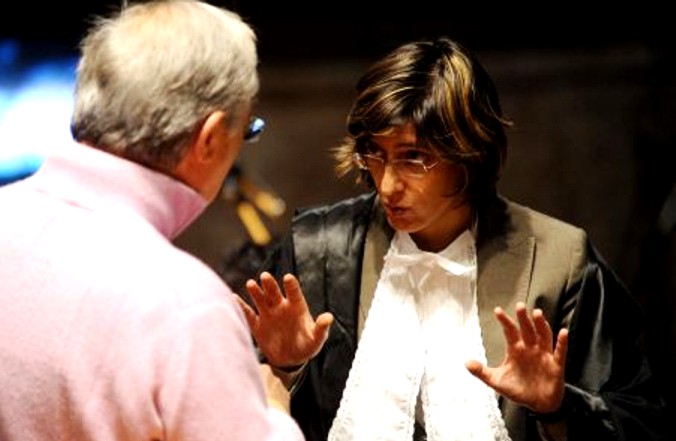
More and more and more wrong facts and libels are being turned up in Sollecito’s pathetic book, both by us here and by an irritated officialdom in Rome and Perugia.
Amanda Knox is rumored to perhaps be mentally unstable and figuratively locked in the attic in Seattle. Now Sollecito seems to have been disappeared back in Italy for his own good as well.
Sollecito’s own lawyers (who have in the past threatened to walk) and his own family have already thrown him to the wolves on Italian TV over just one highly libelous claim and there are an estimated two dozen more still to surface.
Not really a good idea to write a shrill “I’m the real victim here” book unchaperoned, when you have the smug mentality of a 12-year-old. The facts strongly against you. A very bright prosecutor. And a ghost writer whose slobbering over a laughably fictional Sollecito suggests he has a something of a boy-crush.
Raffaele Sollecito has made many stupid claims in his book, but perhaps none is so obvious and more idiotic than his claims about the “lost” emails.
What is it with this guy and the emails? He seems to think (or perhaps, thinks that the readers are stupid enough to believe) that if a computer or a hard drive is destroyed, all the emails in it are lost as well. Come on already, surely they taught him the mechanisms of email in his computer classes.
Look at his statements regarding emails. In chapter 2 (Love and Death) of his book, he describes the morning after the murder -
I’d been up several times in the night””listening to music, answering e-mail, making love””and wanted only to go back to sleep
Right, so he got up many times in the night to answer e-mails. You’d think that this would be his biggest alibi for the night of the murder, right? No, wrong. Raffaele could not prove his alibi because, in his own words -
I did not yet know that the Polizia Postale””supposedly experts in handling technology issues””had seized two of my computers along with Amanda’s and Meredith’s and somehow wrecked three of the four hard disks while trying to decipher them. The bottom line was that the damaged disks were now deemed unreadable. That left just my MacBook Pro to provide an alibi for the night of the murder.
But modern emails DON"T EVEN RESIDE on local hard drives unless one DELIBERATELY downloads them. And even if one does (and hardly anyone ever does) there rarely is reason to completely delete the original, and here there seems about zero reason to do that.
And even if the original IS deleted Facebook and email services have shown under legal pressure that they maintain complete backups going back many months. No way Sollecito’s supposed emails on the night could have been made to simply no longer exist.
Again, when he talks about Amanda and Meredith’s friendship, he says -
If either Meredith’s or Amanda’s computer had survived the police examination, there might have been photographs, emails, and other evidence to point to a more meaningful interaction
Here we go with the elusive emails again. Will someone explain the point of email to this guy? What difference would the local computers surviving or not surviving make to any emails residing on his host’s servers?
He actually has the nerve to criticize the Polizia Postale’s technical competence after making a statement to the effect that he and Amanda could not retrieve their emails as the hard disks were damaged.
Whether the hard disks were destroyed or not, whether it was the Polizia Postale’s fault or not is hardly important here. Admittedly, Amanda is not a “technical genius” (After all, she does not know how to delete messages from her sent items).
But what is stopping this resident technical genius from simply accessing his email box from some other computer or iphone, and printing out a copy from his sent items? Why doesn’t he ask even one of the happy recipients of his emails - by the way, who were they? - to forward it back to him?
Did all of them delete his mails from their in boxes and trash too? Even if we defy all logic and accept that they did, what’s stopping at least one of them from coming forward and testifying that they received a mail from him that night? Did all of them get selective amnesia at the same time too?
Similarly, if any emails that proved the “close friendship” between Amanda and Meredith existed wouldn’t they still be retrievable from Amanda’s mailbox? She could have printed a copy any time. Did she go around deleting all of Meredith’s mails the minute they arrived as well as her own replies to them, and clearing her trash box and all her host’s backups as well, just to be doubly sure they can’t be retrieved?.
Ok, let’s say the emails were deleted. What about the photographs? If there had been any photographs that would establish their “close” friendship, wouldn’t they be there on the camera or phone from which they were taken? Or wouldn’t either Meredith or Amanda have sent them to someone or posted them on their Facebook?
How did EVERYTHING vanish without a trace? If neither of them ever sent the photos to anyone or posted them online anywhere, or even kept them on file, you really have to wonder what was the point of taking them at all.
No one is claiming that Amanda and Meredith were at loggerheads all the time, they might even have gotten along initially. Meredith was not a person who judged people harshly. By all accounts, she did try her best to get along with Amanda, trying to include her in outings and defending her when she got into trouble.
It was Amanda who pulled away saying she wanted to socialize only with Italians. But the fact is that there were clashes and there were differences between them. Trying to make out that they were the best of friends by claiming the destruction of non-existent proofs is not only unbelievable but also utterly stupid.
Like our main poster Hopeful summarized it: this claimed computer genius has never in four years been able to prove he sent an email? Ridiculous.

